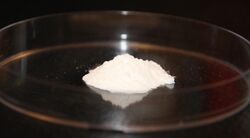Chemistry:Phenolphthalein

| |

| |
| Names | |
|---|---|
| Preferred IUPAC name
3,3-Bis(4-hydroxyphenyl)-2-benzofuran-1(3H)-one | |
| Other names
3,3-Bis(4-hydroxyphenyl)isobenzofuran-1(3H)-one
| |
| Identifiers | |
3D model (JSmol)
|
|
| ChEMBL | |
| ChemSpider | |
| DrugBank | |
| KEGG | |
PubChem CID
|
|
| UNII | |
| |
| |
| Properties | |
| C20H14O4 | |
| Molar mass | 318.328 g·mol−1 |
| Appearance | White powder |
| Density | 1.277 g/cm3 (32 °C (90 °F)) |
| Melting point | 258–263 °C (496–505 °F; 531–536 K)[1] |
| 400 mg/l | |
| Solubility in other solvents | Insoluble in benzene and hexane; very soluble in ethanol and ether; slightly soluble in DMSO |
| UV-vis (λmax) | 552 nm (1st) 374 nm (2nd)[1] |
| Pharmacology | |
| 1=ATC code }} | A06AB04 (WHO) |
| Hazards | |
| GHS pictograms |  [1] [1]
|
| GHS Signal word | Danger |
| H341, H350, H361[1] | |
| P201, P281, P308+313[1] | |
| NFPA 704 (fire diamond) | |
Except where otherwise noted, data are given for materials in their standard state (at 25 °C [77 °F], 100 kPa). | |
| Infobox references | |
Phenolphthalein (/fɛˈnɒl(f)θəliːn/[citation needed] feh-NOL(F)-thə-leen) is a chemical compound with the formula C20H14O4 and is often written as "HIn", "HPh", "phph" or simply "Ph" in shorthand notation. Phenolphthalein is often used as an indicator in acid–base titrations. For this application, it turns colorless in acidic solutions and pink in basic solutions. It belongs to the class of dyes known as phthalein dyes.
Phenolphthalein is slightly soluble in water and usually is dissolved in alcohols in experiments. It is a weak acid, which can lose H+ ions in solution. The nonionized phenolphthalein molecule is colorless and the double deprotonated phenolphthalein ion is fuchsia. Further proton loss in higher pH occurs slowly and leads to a colorless form. Phenolphthalein ion in concentrated sulfuric acid is orange red due to sulfonation.[2]
Uses
pH indicator
| Phenolphthalein (pH indicator) | ||
| below pH 8.3 | above pH 10.0 | |
| 8.3 | ⇌ | 10.0 |
Phenolphthalein's common use is as an indicator in acid-base titrations. It also serves as a component of universal indicator, together with methyl red, bromothymol blue, and thymol blue.[3]
Phenolphthalein adopts different forms in aqueous solution depending on the pH of the solution.[4][2][5][6] Inconsistency exists in the literature about hydrated forms of the compounds and the color of sulfuric acid. Wittke reported in 1983 that it exists in protonated form (H3In+) under strongly acidic conditions, providing an orange coloration. However, a later paper suggested that this color is due to sulfonation to phenolsulfonphthalein.[2]
The lactone form (H2In) is colorless between strongly acidic and slightly basic conditions. The doubly deprotonated (In2-) phenolate form (the anion form of phenol) gives the familiar pink color. In strongly basic solutions, phenolphthalein is converted to its In(OH)3− form, and its pink color undergoes a rather slow fading reaction[6] and becomes completely colorless when pH is greater than 13.
The pKa values of phenolphthalein were found to be 9.05, 9.50 and 12 while those of phenolsulfonphthalein are 1.2 and 7.70.[2]
| Species | H3In+ | H2In | In2− | In(OH)3− |
|---|---|---|---|---|
| Structure |  |
80px | 80px | 
|
| Model |  |
80px | 80px | 
|
| pH | <−1 in H2SO4[4] | 0–8.3 | 8.3–10.0[7] | >12 |
| Conditions | strongly acidic | acidic or near-neutral | basic | strongly basic |
| Color | orange | colorless | pink to fuchsia | colorless |
| Image |  |
 |

|
| An animation of the pH-dependent reaction mechanism: H3In+ → H2In → In2− → In(OH)3− |
Carbonation of concrete
Phenolphthalein's pH sensitivity is exploited in other applications: concrete has naturally high pH due to the calcium hydroxide formed when Portland cement reacts with water. As the concrete reacts with carbon dioxide in the atmosphere, pH decreases to 8.5–9. When a 1% phenolphthalein solution is applied to normal concrete, it turns bright pink. However, if it remains colorless, it shows that the concrete has undergone carbonation. In a similar application, some spackling used to repair holes in drywall contains phenolphthalein. When applied, the basic spackling material retains a pink color; when the spackling has cured by reaction with atmospheric carbon dioxide, the pink color fades.[8]
Education
In a highly basic solution, phenolphthalein's slow change from pink to colorless as it is converted to its Ph(OH)3− form is used in chemistry classes for the study of reaction kinetics.
Entertainment
Phenolphthalein is used in toys, for example as a component of disappearing inks, or disappearing dye on the "Hollywood Hair" Barbie hair. In the ink, it is mixed with sodium hydroxide, which reacts with carbon dioxide in the air. This reaction leads to the pH falling below the color change threshold as hydrogen ions are released by the reaction:
To develop the hair and "magic" graphical patterns, the ink is sprayed with a solution of hydroxide, which leads to the appearance of the hidden graphics by the same mechanism described above for color change in alkaline solution. The pattern will eventually disappear again because of the reaction with carbon dioxide. Thymolphthalein is used for the same purpose and in the same way, when a blue color is desired.[9]
Detection of blood
A reduced form of phenolphthalein, phenolphthalin, which is colorless, is used in a test to identify substances thought to contain blood, commonly known as the Kastle–Meyer test. A dry sample is collected with a swab or filter paper. A few drops of alcohol, then a few drops of phenolphthalin, and finally a few drops of hydrogen peroxide are dripped onto the sample. If the sample contains hemoglobin, it will turn pink immediately upon addition of the peroxide, because of the generation of phenolphthalein. A positive test indicates the sample contains hemoglobin and, therefore, is likely blood. A false positive can result from the presence of substances with catalytic activity similar to hemoglobin. This test is not destructive to the sample; it can be kept and used in further tests. This test has the same reaction with blood from any animal whose blood contains hemoglobin, including almost all vertebrates; further testing would be required to determine whether it originated from a human.
Laxative
Phenolphthalein has been used for over a century as a laxative, but is now being removed from over-the-counter laxatives[10] over concerns of carcinogenicity.[11][12] Laxative products formerly containing phenolphthalein have often been reformulated with alternative active ingredients: Feen-a-Mint[13] switched to bisacodyl, and Ex-Lax[14] was switched to a senna extract.
Thymolphthalein is a related laxative made from thymol.
Despite concerns regarding its carcinogenicity based on rodent studies, the use of phenolphthalein as a laxative is unlikely to cause ovarian cancer.[15] Some studies suggest a weak association with colon cancer, while others show none at all.[16]
Phenolphthalein is described as a stimulant laxative.[16] In addition, it has been found to inhibit human cellular calcium influx via store-operated calcium entry (SOCE, see Template:Link section) in vivo. This is effected by its inhibiting thrombin and thapsigargin, two activators of SOCE that increase intracellular free calcium.[17]
Phenolphthalein has been added to the European Chemicals Agency's candidate list for substance of very high concern (SVHC).[18] It is on the IARC group 2B list for substances "possibly carcinogenic to humans".[19]
The discovery of phenolphthalein's laxative effect was due to an attempt by the Hungarian government to label[clarification needed] genuine local white wine with the substance in 1900. Phenolphthalein did not change the taste of the wine and would change color when a base is added, making it a good label in principle. However, it was found that ingestion of the substance led to diarrhea. Max Kiss, a Hungarian-born pharmacist residing in New York, heard about the news and launched Ex-Lax in 1906.[20][19]
Synthesis
Phenolphthalein can be synthesized by condensation of phthalic anhydride with two equivalents of phenol under acidic conditions. It was discovered in 1871 by Adolf von Baeyer.[21][22][23]

The reaction can also be catalyzed by a mixture of zinc chloride and thionyl chloride.[25]
See also
References
- ↑ 1.0 1.1 1.2 1.3 1.4 "Phenolphthalein". https://www.sigmaaldrich.com/catalog/product/sial/105945.
- ↑ 2.0 2.1 2.2 2.3 Tamura, Zenzo (December 1996). "Spectrophotometric Analysis of the Relationship between Dissociation and Coloration, and of the Structural Formulas of Phenolphthalein in Aqueous Solution". Analytical Sciences 12 (6): 927–930. doi:10.2116/analsci.12.927.
- ↑ "Universal Indicator". ISCID Encyclopedia of Science and Philosophy. https://www.iscid.org/encyclopedia/Universal_Indicator.
- ↑ 4.0 4.1 Wittke, Georg (1 March 1983). "Reactions of phenolphthalein at various pH values". Journal of Chemical Education 60 (3): 239. doi:10.1021/ed060p239. ISSN 0021-9584. Bibcode: 1983JChEd..60..239W.
- ↑ Abdel-Hamid, Refat (1 September 1998). "The Adsorption Behavior of Phenolphthalein at a Mercury Electrode in Water-Ethanol Solutions". Monatshefte für Chemie - Chemical Monthly 129 (8): 817–826. doi:10.1007/PL00013491.
- ↑ 6.0 6.1 Kunimoto, Ko-Ki (February 2001). "Molecular structure and vibrational spectra of phenolphthalein and its dianion". Spectrochimica Acta Part A 57 (2): 265–271. doi:10.1016/S1386-1425(00)00371-1. PMID 11206560. Bibcode: 2001AcSpA..57..265K.
- ↑ Rathod, Balraj B.; Murthy, Sahana; Bandyopadhyay, Subhajit (20 February 2019). "Is this Solution Pink Enough? A Smartphone Tutor to Resolve the Eternal Question in Phenolphthalein-Based Titration". Journal of Chemical Education 96 (3): 486–494. doi:10.1021/acs.jchemed.8b00708. Bibcode: 2019JChEd..96..486R.
- ↑ Ronald D. Kurp, "Ready to use spackle/repair product containing dryness indicator", US patent 6531528, published 2003-03-11
- ↑ "Toystore". https://www.chymist.com/Toystore%20part3.pdf.
- ↑ Spiller, H. A.; Winter, M. L.; Weber, J. A.; Krenzelok, E. P.; Anderson, D. L.; Ryan, M. L. (May 2003). "Skin Breakdown and Blisters from Senna-Containing Laxatives in Young Children". The Annals of Pharmacotherapy 37 (5): 636–639. doi:10.1345/aph.1C439. PMID 12708936.
- ↑ Dunnick, J. K.; Hailey, J. R. (1996). "Phenolphthalein Exposure Causes Multiple Carcinogenic Effects in Experimental Model Systems". Cancer Research 56 (21): 4922–4926. PMID 8895745. https://cancerres.aacrjournals.org/content/56/21/4922.full.pdf. Retrieved 2022-02-22.
- ↑ Tice, R. R.; Furedi-Machacek, M.; Satterfield, D.; Udumudi, A.; Vasquez, M.; Dunnick, J. K. (1998). "Measurement of Micronucleated Erythrocytes and DNA Damage during Chronic Ingestion of Phenolphthalein in Transgenic Female Mice Heterozygous for the p53 Gene". Environmental and Molecular Mutagenesis 31 (2): 113–124. doi:10.1002/(SICI)1098-2280(1998)31:2<113::AID-EM3>3.0.CO;2-N. PMID 9544189.
- ↑ "Phenolphthalein". https://www.drugbank.ca/drugs/DB04824.
- ↑ Stolberg, Sheryl Gay (August 30, 1997). "3 Versions of Ex-Lax Are Recalled After F.D.A. Proposes Ban on Ingredient". The New York Times. https://www.nytimes.com/1997/08/30/us/3-versions-of-ex-lax-are-recalled-after-fda-proposes-ban-on-ingredient.html.
- ↑ Cooper, G. S.; Longnecker, M. P.; Peters, R. K. (2004). "Ovarian Cancer Risk and Use of Phenolphthalein-Containing Laxatives". Pharmacoepidemiology and Drug Safety 13 (1): 35–39. doi:10.1002/pds.824. PMID 14971121. https://zenodo.org/record/1229318. Retrieved 2019-06-26.
- ↑ 16.0 16.1 "Other pharmaceutical agents.". IARC monographs on the evaluation of carcinogenic risks to humans. 76. International Agency for Research on Cancer. 2000. pp. 345–486. https://www.ncbi.nlm.nih.gov/books/NBK401424/.
- ↑ Dobrydneva, Y.; Wilson, E.; Abelt, C. J.; Blackmore, P. F. (2009). "Phenolphthalein as a Prototype Drug for a Group of Structurally Related Calcium Channel Blockers in Human Platelets". Journal of Cardiovascular Pharmacology 53 (3): 231–240. doi:10.1097/FJC.0b013e31819b5494. PMID 19247192.
- ↑ "Phenolphthalein - Substance Information - ECHA" (in en-GB). https://echa.europa.eu/substance-information/-/substanceinfo/100.000.914.
- ↑ 19.0 19.1 Arney, Kat (2018-10-25). "Phenolphthalein" (in en). https://www.chemistryworld.com/podcasts/phenolphthalein/3009674.article.
- ↑ May, Paul. "Phenolphthalein - Molecule of the Month - March 2022 (HTML version)". https://www.chm.bris.ac.uk/motm/phenolphthalein/phphh.htm.
- ↑ Baeyer, A. (1871). "Ueber eine neue Klasse von Farbstoffen". Berichte der Deutschen Chemischen Gesellschaft 4 (2): 555–558. doi:10.1002/cber.18710040209. https://zenodo.org/record/1425008. Retrieved 2020-09-02.
- ↑ Baeyer, A. (1871). "Ueber die Phenolfarbstoffe". Berichte der Deutschen Chemischen Gesellschaft 4 (2): 658–665. doi:10.1002/cber.18710040247. https://zenodo.org/record/1425010. Retrieved 2019-06-26.
- ↑ Baeyer, A. (1871). "Ueber die Phenolfarbstoffe". Polytechnisches Journal 201 (89): 358–362. https://dingler.culture.hu-berlin.de/article/pj201/ar201089. Retrieved 2022-02-22.
- ↑ Max Hubacher, U.S. Patent 2,192,485 (1940 to Ex Lax Inc)
- ↑ U.S. Patent 2,522,939
External links
 |


